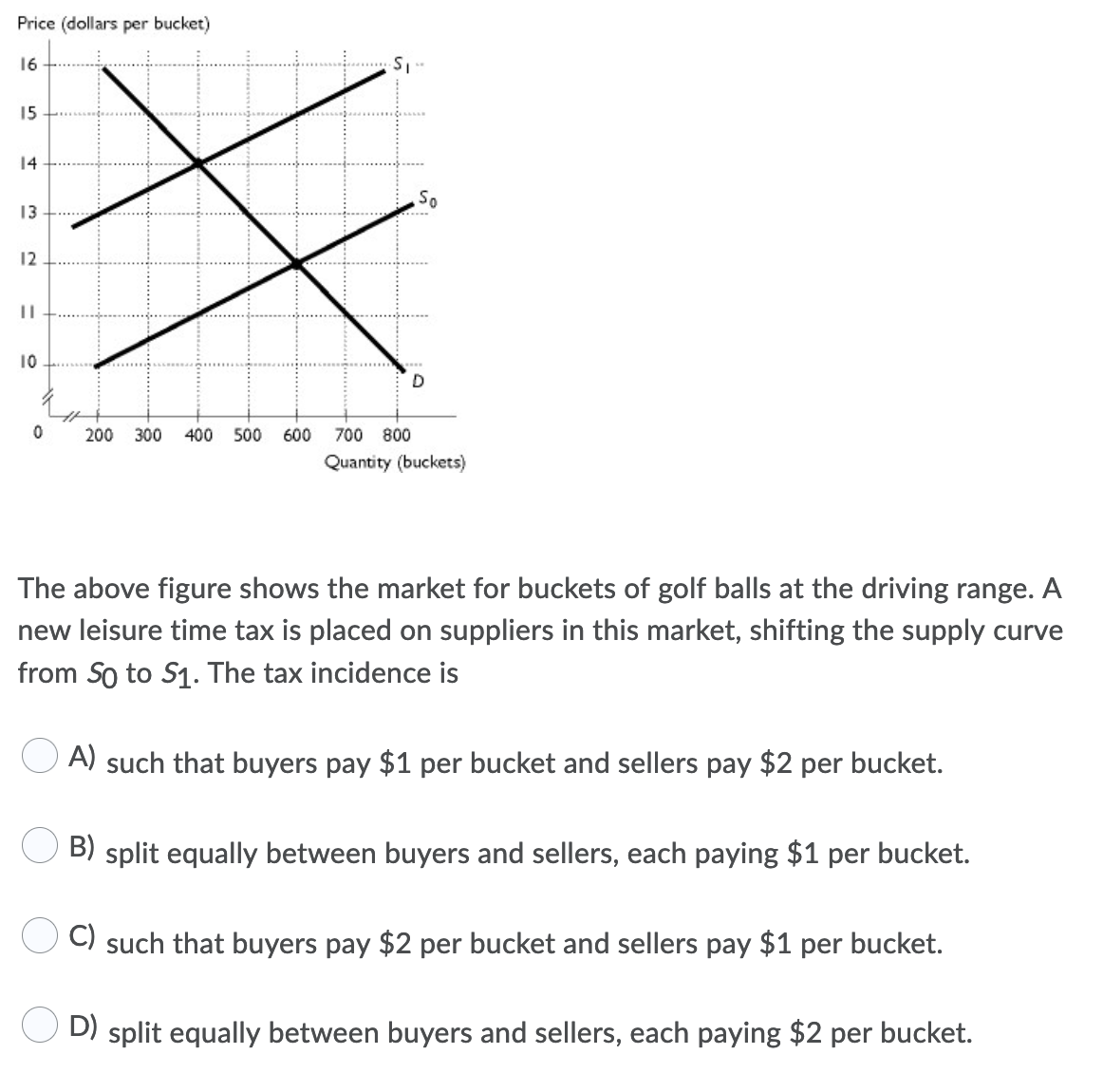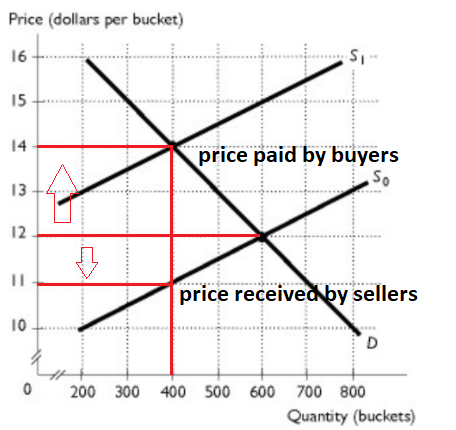Price (dollars per bucket) 16 15 14 13 12 10 200 300 400 500 600 700 800 Quantity (buckets) The above figure shows the market for buckets of golf balls at the driving range. A new leisure time tax is placed on suppliers in this market, shifting the supply curve from So to S1. The tax incidence is A) such that buyers pay $1 per bucket and sellers pay $2 per bucket. B) split equally between buyers and sellers, each paying $1 per bucket. C) such that buyers pay $2 per bucket and sellers pay $1 per bucket. D) split equally between buyers and sellers, each paying $2 per bucket. %3D
Price (dollars per bucket) 16 15 14 13 12 10 200 300 400 500 600 700 800 Quantity (buckets) The above figure shows the market for buckets of golf balls at the driving range. A new leisure time tax is placed on suppliers in this market, shifting the supply curve from So to S1. The tax incidence is A) such that buyers pay $1 per bucket and sellers pay $2 per bucket. B) split equally between buyers and sellers, each paying $1 per bucket. C) such that buyers pay $2 per bucket and sellers pay $1 per bucket. D) split equally between buyers and sellers, each paying $2 per bucket. %3D
Managerial Economics: A Problem Solving Approach
5th Edition
ISBN:9781337106665
Author:Luke M. Froeb, Brian T. McCann, Michael R. Ward, Mike Shor
Publisher:Luke M. Froeb, Brian T. McCann, Michael R. Ward, Mike Shor
Chapter6: Simple Pricing
Section: Chapter Questions
Problem 9MC
Related questions
Question
100%

Transcribed Image Text:Price (dollars per bucket)
16
15
14
13
12
10
200 300
400
500
600
700
800
Quantity (buckets)
The above figure shows the market for buckets of golf balls at the driving range. A
new leisure time tax is placed on suppliers in this market, shifting the supply curve
from So to S1. The tax incidence is
A) such that buyers pay $1 per bucket and sellers pay $2 per bucket.
B) split equally between buyers and sellers, each paying $1 per bucket.
C) such that buyers pay $2 per bucket and sellers pay $1 per bucket.
O D) split equally between buyers and sellers, each paying $2 per bucket.
%3D
Expert Solution
Step 1
Answer:

According to the above figure, due to tax the supply curve shifts to the left from S0 to S1. The new equilibrium price is $14. $14 is the price paid after tax by the buyers. The corresponding price on the old supply curve i.e. $11 is the price received by sellers after tax.
Incidence of tax on buyers = Price paid after-tax - Equilibrium price
Incidence of tax on buyers = 14 -12 = $2
The price paid by buyers has increased by $2.
And,
Incidence of tax on sellers = Equilibrium price - Price received by sellers
Incidence of tax on sellers = 12 - 11 = $1
The price received by sellers has decreased by $1.
Trending now
This is a popular solution!
Step by step
Solved in 2 steps with 1 images

Knowledge Booster
Learn more about
Need a deep-dive on the concept behind this application? Look no further. Learn more about this topic, economics and related others by exploring similar questions and additional content below.Recommended textbooks for you

Managerial Economics: A Problem Solving Approach
Economics
ISBN:
9781337106665
Author:
Luke M. Froeb, Brian T. McCann, Michael R. Ward, Mike Shor
Publisher:
Cengage Learning

Managerial Economics: A Problem Solving Approach
Economics
ISBN:
9781337106665
Author:
Luke M. Froeb, Brian T. McCann, Michael R. Ward, Mike Shor
Publisher:
Cengage Learning